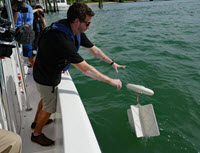
Many ocean forecast models treat the upper 1 meter of the water column, which plays a central role in ocean material transport, as a single layer. However, recent research shows that currents act differently at various depths within this meter.
The use of ocean drifters is the oldest way to measure currents, and recent design advances are providing more detailed and accurate ocean current data than ever. John Lodise analyzes data from these improved drifters to observe near-surface currents at multiple depths and explores how wind-driven velocities influence them. “If we know exactly how the wind is going to affect surface currents, then we can analyze forecasted wind and wave conditions to better predict the movement of surface currents and the pollution being transported by them,” he said.
John is a Ph.D. student with the University of Miami’s Rosenstiel School of Marine and Atmospheric Science and a GoMRI Scholar with Consortium for Advanced Research on Transport of Hydrocarbon in the Environment II (CARTHE II).
His Path

John grew up on Long Island, New York where the ocean was part of his life through fishing, beach trips, and surfing. John, as an undergraduate at the University of Delaware, explored scientific fields related to ocean science and ultimately chose physical oceanography. “Being able to understand the movement and circulation of the ocean is so important to solving many of today’s environmental issues,” he said. “I thought physical oceanography was an avenue where I could really make a contribution to the current scientific understanding.” He graduated in 2015 with a Bachelor’s degree in environmental science and concentrations in atmospheric science and physical oceanography.
While researching potential graduate programs, John was immediately impressed and motivated by the CARTHE research taking place at the University of Miami’s Rosenstiel School of Marine and Atmospheric Science. He applied to the program and accepted a position in Dr. Tamay Özgökmen’s ocean sciences lab, where researchers are conducting studies on ocean transport of floating material such as Deepwater Horizon oil. “I’ve always felt a connection to the ocean, and with that comes an obligation to try and protect it and all the resources it provides,” said John. “What’s most important for me is being part of a community that’s actively working towards protecting oceans, beaches, the ecosystems that exist there, and oceanic resources that humans depend on.”
His Work
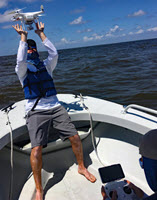
John deconstructs surface currents using data from drifters deployed during the Lagrangian Submesoscale Experiment (LASER), which used a fully-coupled atmosphere-wave-ocean model to calculate the physical variables involved in currents. John first applies the Lagrangian Variational Analysis (LAVA) tool to estimate velocity fields in the study region when wind and wave action is minimal. Doing so allows him to capture the underlying circulation patterns not driven by wind and waves. He then analyzes how drifter velocity changes when wind and wave activity increase and defines the total surface current into separate components driven by wind, waves, and underlying circulation patterns.
Drifters used during LASER had drogues (an attached flexible tether with sensing instruments that collected data 60 cm below the surface); however, a significant number of them lost their drogues due to bad weather and only collected data 5 cm below the surface. John assesses data from drifters with and without drogues to calculate wind-driven currents at these different depths. “The ocean surface is very difficult to sample, but it’s where buoyant pollutants like oil reside,” he said. “Including data from undrogued drifters, which sit right at the surface, can provide needed insight into this area.”
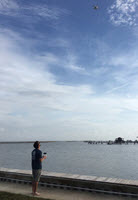
So far, John has observed that wind and wave forcing caused significant changes in water column velocity as his calculations neared the ocean surface, consistent with recent CARTHE studies (Laxague et.al., 2017 and Haza et al., 2018). Undrogued drifters traveled approximately 1.5 times faster than drogued drifters due to wind and wave influence. Furthermore, while wind-driven currents are known to travel to the right of the wind direction, he observed that currents deeper in the water column traveled further to the right than shallower currents.
John plans to investigate if convergence zones transport or hold surface debris between different water masses and how large wind and wave events change the structure of existing ocean currents and what happens after the wind and waves subside. He also plans to compare LASER data with data collected during the Grand Lagrangian Deployment (GLAD) and Submesoscale Processes and Lagrangian Analysis on the Shelf (SPLASH) experiments to explore how factors such as seasonality and regional effects influence surface drifter transport.
His Learning
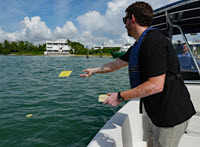
Working with Dr. Özgökmen provided John the opportunity to participate in major Gulf of Mexico field experiments that used technologies such as GPS-equipped ocean drifters, drones, planes, and satellites to measure ocean currents. He gained experience assembling and deploying drifters during the LASER project and took part in small boat operations, drifter deployments, and drone experiments during SPLASH. Prior to these large field experiments, there were months of preparation and collaboration. “It was an amazing experience being out on the Gulf of Mexico, living aboard a ship, and building and deploying ocean drifters with the whole scientific team,” he said. “Being part of this large group of scientists working towards a common goal was not only a lot of fun but also made me proud to be part of the CARTHE group and work on the leading edge of oceanography.”
His Future
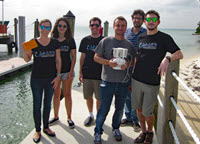
John plans to seek a position at a university, government agency, or private environmental agency after completing his Ph.D. and hopes to continue his current research path. “The career I’ve chosen has given me amazing opportunities to travel while conducting and presenting my research,” he said. “I love the work that I do.”
Praise for John
Dr. Özgökmen praised John’s work with the consortium’s LASER and SPLASH experiments, which provided data to John’s ongoing Ph.D. research. He explained, “[Our research] is a very special project, facilitating collaboration at an unprecedented level and duration across oceanographic sciences and communities.”
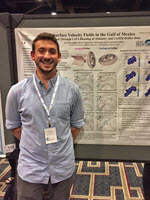
The GoMRI community embraces bright and dedicated students like John Lodise and their important contributions. The GoMRI Scholars Program recognizes graduate students whose work focuses on GoMRI-funded projects and builds community for the next generation of ocean science professionals. Visit the consortia website to learn more about their work.
By Stephanie Ellis and Nilde Maggie Dannreuther. Contact sellis@ngi.msstate.edu for questions or comments.
************
The Gulf of Mexico Research Initiative (GoMRI) is a 10-year independent research program established to study the effect, and the potential associated impact, of hydrocarbon releases on the environment and public health, as well as to develop improved spill mitigation, oil detection, characterization and remediation technologies. An independent and academic 20-member Research Board makes the funding and research direction decisions to ensure the intellectual quality, effectiveness and academic independence of the GoMRI research. All research data, findings and publications will be made publicly available. The program was established through a $500 million financial commitment from BP. For more information, visit https://gulfresearchinitiative.org/.
© Copyright 2010-2019 Gulf of Mexico Research Initiative (GoMRI) – All Rights Reserved. Redistribution is encouraged with acknowledgement to the Gulf of Mexico Research Initiative (GoMRI). Please credit images and/or videos as done in each article. Questions? Contact web-content editor Nilde “Maggie” Dannreuther, Northern Gulf Institute, Mississippi State University (maggied@ngi.msstate.edu).
